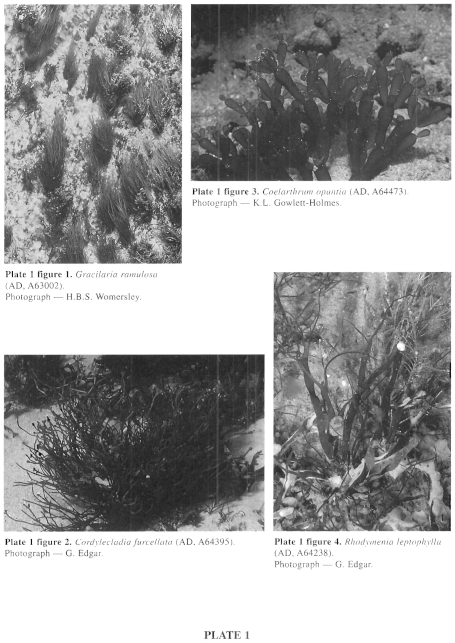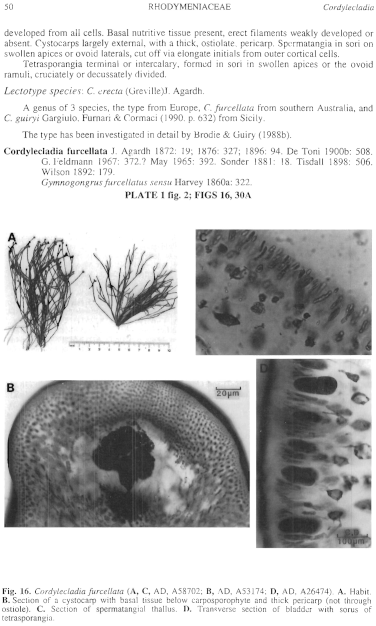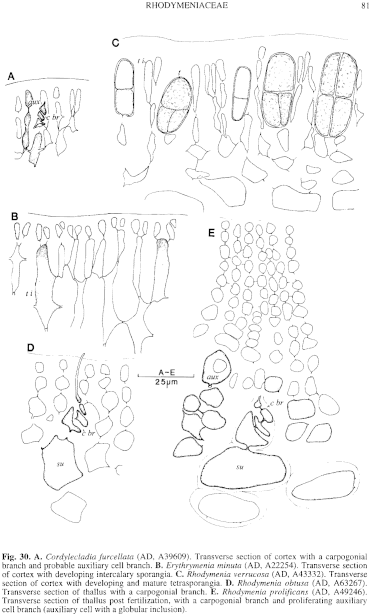|
|
|
|
|
|||||||||||
|
Electronic Flora of South Australia Species Fact Sheet
Phylum Rhodophyta – Class Florideophyceae – Order Rhodymeniales – Family Rhodymeniaceae
Selected citations: De Toni 1900b: 508. G. Feldmann 1967: 372.? May 1965: 392. Sonder 1881: 18. Tisdall 1898: 506. Wilson 1892: 179.
Synonym
Gymnogongrus furcellatus sensu Harvey 1860a: 322.
Thallus (Fig. 16A) dark red-brown, cartilaginous, 10–25 cm high, with numerous erect, linear, terete to slightly compressed, branches from a basal crust. Branches sparsely and irregularly branched (often subdichotomous) at intervals of (1–) 2–6 cm, solid, 0.7–1 mm in diameter or broad from base to apices, with swollen or ovoid fertile laterals 1.2–2.5 mm long and 0.9–1.5 mm in diameter near the branch apices. Holdfast crustose, 2–10 mm across; epilithic. Structure multiaxial, developing a cortex 3–5 cells broad, outer cells ovoid and 2–4 (–5) µm in diameter, grading fairly abruptly to a medulla of compact angular cells becoming 80–120 µm across, walls 4–8 µm thick, with no or very slight intercellular spaces and with few secondary pit-connections. Rhodoplasts discoid to elongate, ribbon like in inner cells.
Reproduction: Fertile structures formed in swollen apices or the ovoid lateral ramuli, these being shed after maturity and often becoming hollow by breakdown of the central medullary cells. Gametangial thalli dioecious. Carpogonial branches (Fig. 30A) 3-celled, borne on inner cortical cells together with a 2-celled auxiliary cell branch. Carposporophyte dendroid, with a basal fusion cell, branched above, and several lobes of ovoid to angular carposporangia 8–12 µm in diameter. Basal nutritive tissue prominent, with the erect filaments largely disintegrating, with cells adjacent to the pericarp remaining stellate. Cystocarps (Fig. 16B) single or crowded, sessile and largely protuberant, 1–2 mm across, pericarp 200–300 µm thick, with a narrow ostiole. Spermatangia (Fig. 16C) cut off from outer cortical cells via elongate initials, ovoid, 2–3 µm in diameter.
Tetrasporangia (Fig. 16D) scattered or in slight sori in the outer cortex, with elongate cortical cells, basally pit-connected, elongate-ovoid, 30–45 µm long and 12–20 µm in diameter, cruciately or (usually) decussately divided.
Type from Port Phillip Heads, Vic. (Harvey, Alg. Aust. Exsicc. 395E); holotype in Herb. Agardh, LD, 26690.
Selected specimens: "The Amphitheatre", West I., S. Aust., 10–20 m deep (Edyvane, 24.v.1982; AD, A53174). Robe, S. Aust., 13 m deep (Mitchell, 25.v.1963; AD, A26474); 0–2 m deep near jetty (Womersley, 26.ix.1992; AD, A62818) and 1 m deep in shaded pool, outer coast (Guiry, 4.vii.1988; AD, A58702). Nora Creina, S. Aust., 3–8 m deep (Owen, 3.ix.1971; AD, A39609) and 5–6 m deep (R. Lewis & Kraft, 13.v.1972; AD, A42220). Port MacDonnell, S. Aust., drift (Womersley, 2.xii.1989; AD, A60030). Point Lonsdale, Vic., 14 in deep (Macpherson, 15.v.1963; AD, A28925). Portsea, Vic., 3–5 m deep near jetty (Kraft 8978 & Saunders, 24.iii.1992; MELU). Flinders, Vic., 20 m deep (Millar, 20.iii.1988; MELU; AD, A63404). Swan I., NE Tas., 5–8 m deep (Edgar, 15.iv.1995; AD, A64395). Lady Bay, Southport, Tas., 7 m deep (Brown & Kenchington, 14.x.1986; AD, A57692).
Distribution: West I., S. Aust., to Flinders, Vic., and the E coast of Tasmania.
Taxonomic notes: This taxon was first recognised by Harvey (1860a, p. 322) who referred to it doubtfully as Gymnogongrus furcellatus (C. Agardh) J. Agardh (1851, p. 318). J. Agardh (1872, p. 20) realised this was incorrect, and described it as a new species of Cordylecladia, based on Harvey Alg. Aust. Exsicc. 395 (not 295) from Port Phillip Heads, Vic.
G. Feldmann (1967, p. 372) commented on a specimen from Champion Bay, W. Aust., which was sterile and probably not this species.
Cordylecladia ?australis Harvey is a nomen nudum used by Harvey for his Alg. Aust. Exsicc. 375H from Phillip I., Vic.; it appears to be C. furcellata, based on MEL, 675972.
Cordylecladia furcellata doubtfully belongs to Cordylecladia since the fertile, caducous, bladders are distinct from the swollen upper fertile branches in the type species, the cystocarps have weakly-developed erect filaments from the basal nutritive tissue and the tetrasporangia are basally pit-connected to inner cortical cells and not transformed from intercalary cortical cells as in the type species, C. erecta (Brodie & Guiry 1988b).
References:
AGARDH, J.G. (1851). Species Genera et Ordines Algarum. Vol. 2, Part 1, I-XII, 1–336 + index. (Gleerup: Lund.)
AGARDH, J.G. (1872). Bidrag till Florideernes Systematik. Acta Univ. lund. 8, 1–60.
AGARDH, J.G. (1876). Species Genera et Ordines Algarum. Vol. 3, Part 1 — Epicrisis systematis Floridearum, pp. i-vii, 1–724. (Weigel: Leipzig.)
AGARDH, J.G. (1896). Analecta Algologica. Cont. III. Acta Univ. lund. 32, 1–140, Plate 1.
BRODIE, J. & GUIRY, M.D. (1988b). Life history and reproduction of Cordylecladia erecta (Rhodymeniaceae, Rhodophyta). Br. phycol. J. 23, 347–364.
DE TONI, G.B. (1900b). Sylloge Algarum omnium hucusque Cognitarum. Vol. 4. Florideae. Sect. 2, pp. 387–776. (Padua.)
FELDMANN, G. (1967). Le genre Cordylecladia J. Ag. (Rhodophycées, Rhodyméniales) et sa position systématique. Rev. . 74, 357–375, Plate 1.
MAY, V. (1965). A census and key to the species of Rhodophyceae (red algae) recorded from Australia. Contr. N.S.W. natn. Herb. 3, 349–429.
SONDER, O.W. (1881). In Mueller, F., Fragmenta Phytographiae Australiae. Supplementum ad volumen undecinum: Algae Australianae hactenus cognitae, pp. 1–42, 105–107. (Melbourne.)
TISDALL, H.T. (1898). The algae of Victoria. Rep. 7th Meet. Aust. Ass. Adv. Sci., Sydney, 1898, pp. 493–516.
WILSON, J.B. (1892). Catalogue of algae collected at or near Port Phillip Heads and Western Port. Proc. R. Soc. Vict. 4, 157–190.
The Marine Benthic Flora of Southern Australia Part IIIB complete list of references.
Publication:
Womersley, H.B.S. (28 June, 1996)
The Marine Benthic Flora of Southern Australia
Rhodophyta. Part IIIB. Gracilarialse, Rhodymeniales, Corallinales and Bonnemaisoniales
Reproduced with permission from The Marine Benthic Flora of Southern Australia Part IIIB 1996, by H.B.S. Womersley. Australian Biological Resources Study, Canberra. Copyright Commonwealth of Australia.
Illustrations in Womersley Part IIIA, 1996: PLATE 1 fig. 2; FIGS 16, 30A.

Plate 1 enlarge
PLATE 1
figure 1. Gracilaria ramulosa (AD A63002). Photograph - H.B.S. Womersley.
figure 2. Cordylecladia furcellata (AD, A64395). Photograph - G. Edgar.
figure 3. Coelarthrum opuntia (AD, A64473). Photograph - K.L. Gowlett-Holmes.
figure 4. Rhodymenia leptophylla (AD, A64238). Photograph - G. Edgar.

Figure 16 enlarge
Fig. 16. Cordylecladia furcellata (A, C, AD, A58702; B, AD, A53174; D, AD, A26474). A. Habit. B. Section of a cystocarp with basal tissue below carposporophyte and thick pericarp (not through ostiole). C. Section of spermatangial thallus. D. Transverse section of bladder with sorus of tetrasporangia.

Figure 30 enlarge
Fig. 30. A. Cordylecladia furcellata (AD, A39609). Transverse section of cortex with carpogonial branch and probable auxiliary cell branch. B. Erythrymenia minuta (AD, A22254). Transverse section of cortex with developing intercalary sporangia. C. Rhodymenia verrucosa (AD, A43332). Transverse section of cortex with developing and mature tetrasporangia. D. Rhodymenia obtusa (AD, A63267). Transverse section of thallus with a carpogonial branch. E. Rhodymenia prolificans (AD, A49246). Transverse section of thallus post fertilization, with a carpogonial branch and proliferating auxiliary cell branch (auxiliary cell with a globular inclusion).

|
Email Contact: State Herbarium of South Australia |

|